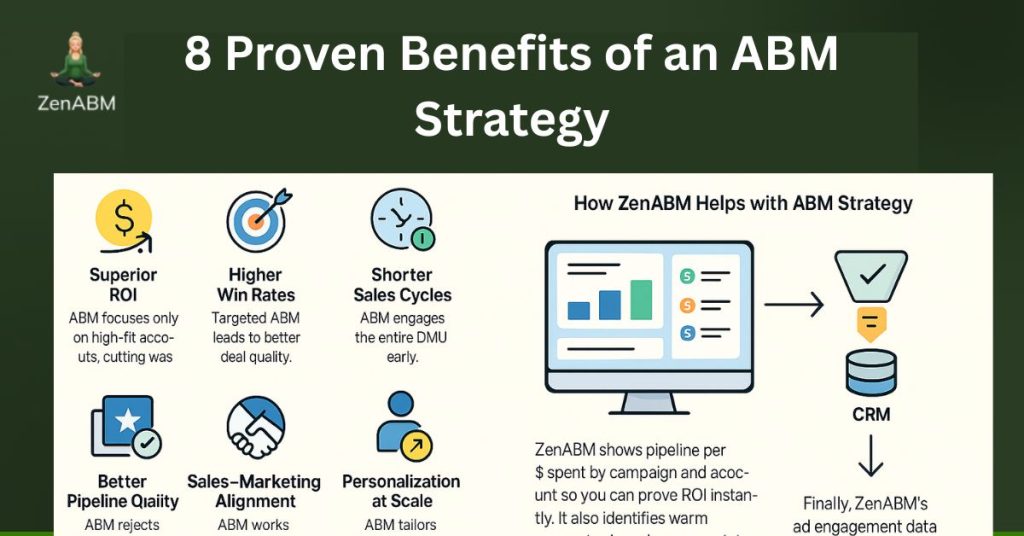Traditional marketing often relies on the “spray and pray” approach.
You churn out generic content and hope leads appear. When they do, you chase them without fully understanding their pain points or fit (and end up getting poor conversions).
Especially in B2B, where buying decisions are logical and complex, you need to target accounts that have both the need and the capacity to pay for your solution.
That’s exactly what ABM does better. To prove its impact, let me show you 8 proven benefits of an ABM strategy and how ZenABM can help you achieve them.
8 Proven Benefits of an ABM Strategy: Quick Overview
- Superior ROI: ABM focuses only on high-fit accounts, cutting waste.
- Higher Win Rates: Targeted ABM leads to better deal quality.
- Larger Deal Sizes: ABM naturally drives bigger contracts.
- Shorter Sales Cycles: ABM engages the entire DMU early.
- Better Pipeline Quality: ABM rejects vanity leads.
- Sales–Marketing Alignment: ABM works when GTM teams align.
- Personalization at Scale: ABM tailors messaging by tier and intent.
- Higher Lifetime Value: ABM supports expansion and retention.
- How ZenABM Helps with ABM Strategy: ZenABM shows pipeline per $ spent by campaign and account so you can prove ROI instantly. It also identifies warm accounts via real engagement data and syncs it to your CRM for timely sales follow-up. This filters out noise by only surfacing accounts that hit clear engagement thresholds. Finally, ZenABM’s ad engagement data and buyer intent push to CRM ensures your sales and marketing teams stay on the same page.
Benefit 1: Superior ROI and Revenue Impact
ABM has proven to drive a higher return on investment 9ROI) than any other marketing approach.
In a recent benchmark, 76% of marketers reported achieving higher ROI with ABM compared to other tactics.
The 2024 ABM Benchmark Report by Demandbase, too, found that leading B2B organizations see 81% higher ROI after adopting account-based strategies.
These claims aren’t theoretical – The numbers are evident in real campaigns.
Userpilot, for example, launched an ABM program that generated over $650,000 in pipeline in 90 days with a staggering $12 in pipeline per $1 spent:
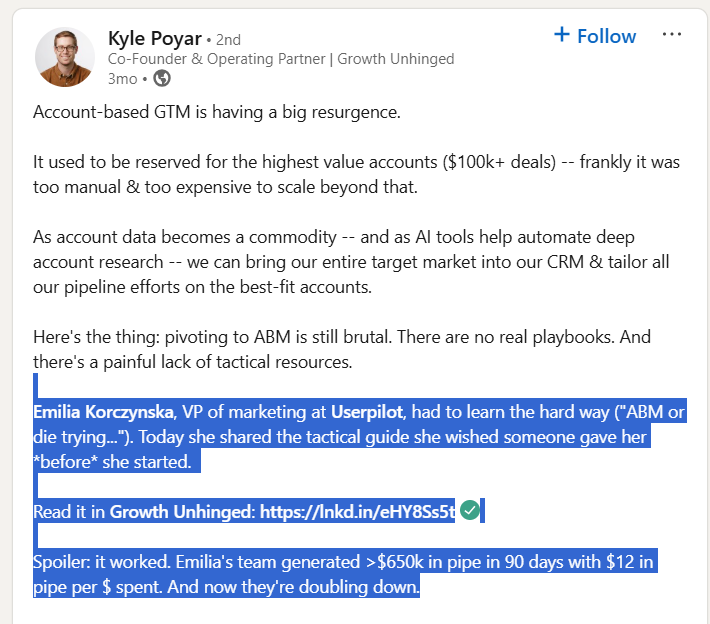
That’s a 12x return in pure pipeline, far outpacing the returns typical of broad inbound or paid lead programs.
Why such a superior ROI?
ABM concentrates resources on the best-fit accounts most likely to convert, eliminating waste on unqualified leads. It also prioritizes metrics tied to revenue.
In fact, companies attribute on average 77% of their revenue growth to ABM efforts, according to an ITSMA study.
Benefit 2: Higher Win Rates and Sales Conversions
ABM doesn’t just fill the funnel.
It dramatically improves how many deals close.
I mean a higher win rate, more-than-usually follows if ABM’s done right.
In fact, companies aligning ABM with targeted account advertising have been seen to achieve 60% higher win rates than those without such a focus.
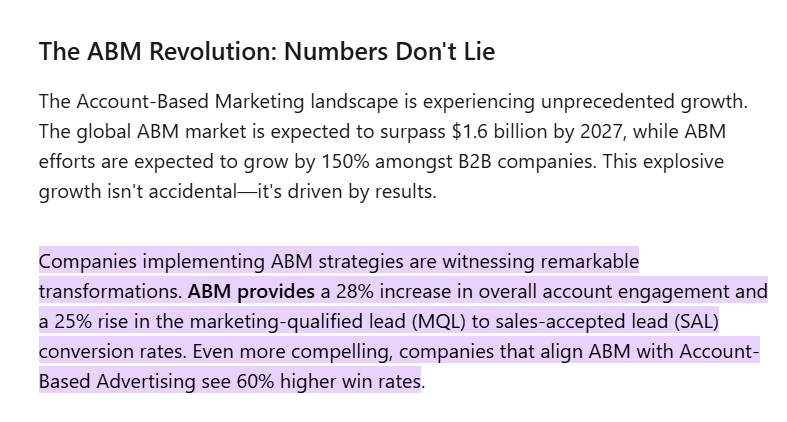
Similarly, tightly aligned sales and marketing teams (a hallmark of ABM) can be 67% more effective at closing deals!
Benefit 3: Larger Deal Sizes and Customer Value
So, I just laid out the reasons and supportive stats regarding how ABM closes more deals.
But here’s more to add to the goodness: ABM deals are usually bigger, too. ABM’s correlation with average contract value (ACV) of deals closed is quite significant.
Supportive statistic?
58% of marketers see the size of their deals increase with ABM programs, reported Forrestor.
And if you are wondering by how much, Intent Amp;ify (a marketing agency), has a claim: The agency was able to reduce its clients’ sales cycle length by an average of 35%.
It was also able to uplift the average deal size by 28%
And they give the credit to their account-based marketing approach
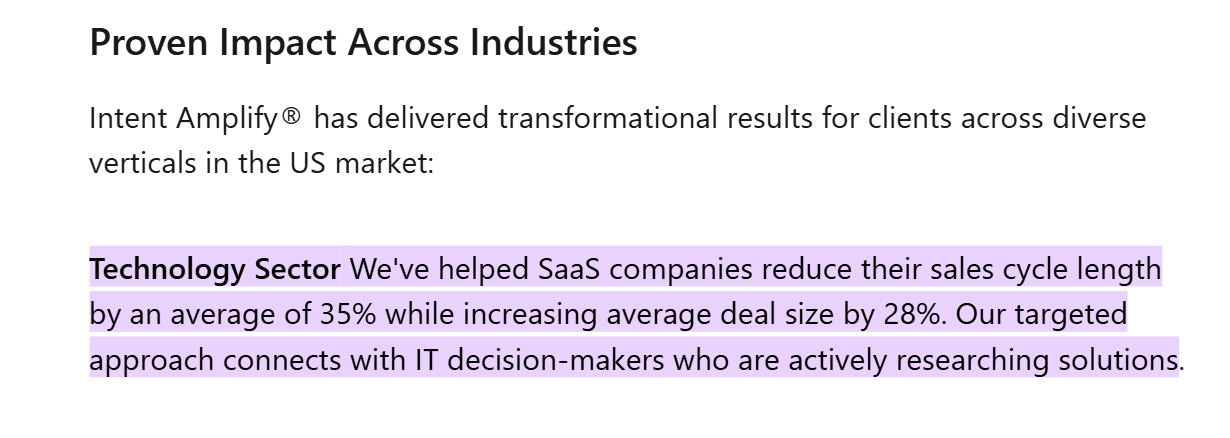
Btw, these bigger wins of ABM aren’t just from net-new customers; ABM also expands existing account value (more on upsells later in the article).
Benefit 4: Shorter Sales Cycle and Faster Pipeline with Deeper Buying Commitment Engagement
B2B sales cycles have always been long and crooked:

And why won’t they be so – I mean, there’s not one person deciding stuff.
In ABM, it’s never leads, it’s DMUs (Decision making units), and seasoned ABM experts like Debjit Sen (Founder at Engrow, an ABM agency) point out that you must never underestimate the size of a DMU/buying committee:
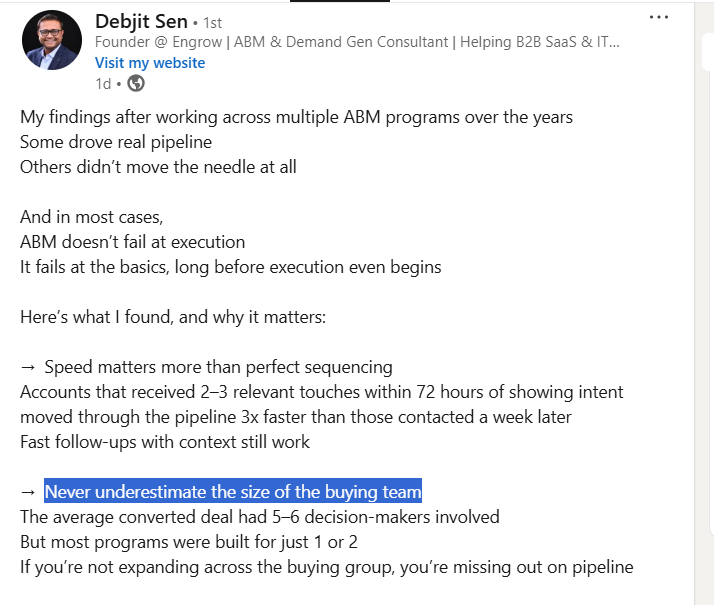
As per 6sense’s B2B Buyer Experience Report, buying committees are getting as big as 11 people!
Now, broad demand gen in this context often leaves sales reps chasing one lead at a time, elongating the journey.
With ABM, marketing and sales teams are forced to focus on all stakeholders in an account instead of ‘leads.’
This deepens the buying team’s engagement and closes deals faster.
For instance, Userpilot’s ABM case study on Kyle Poyar’s Growth Unhinged seconds this:
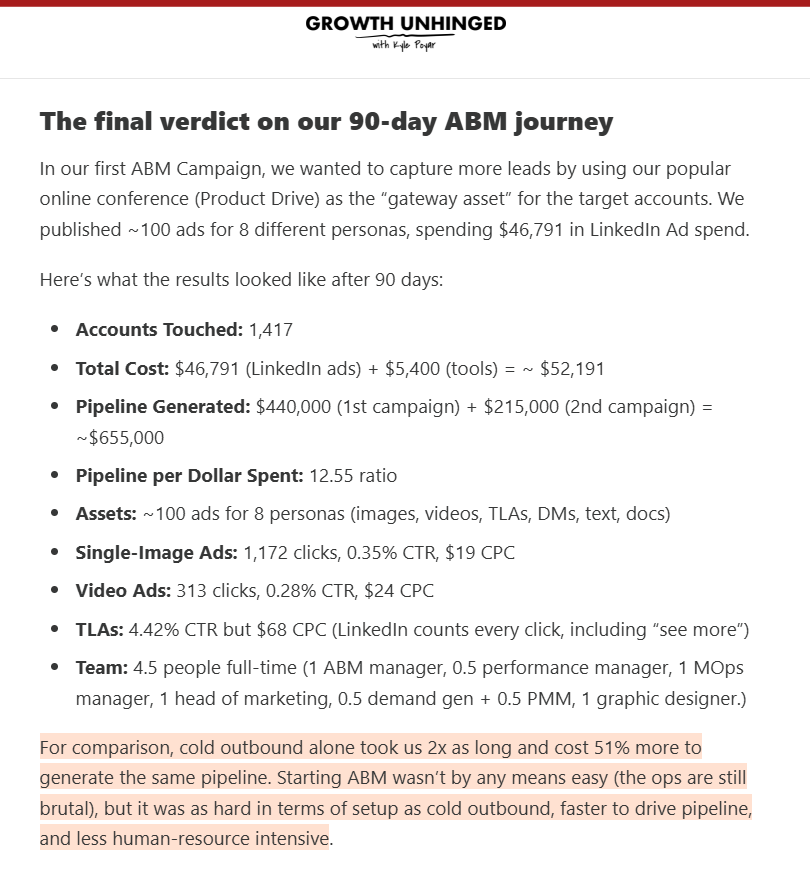
It took the team twice as long and cost 51% more to get the same pipeline with cold outbound than they did with ABM.
Benefit 5: Improved Pipeline Quality & Conversion Rates
ABM flips the focus from quantity to quality, and it shows in the conversion metrics.
Rather than amassing thousands of MQLs that never convert and your sales team despises, ABM brings in a smaller number of highly qualified, sales-ready opportunities.
I mean, raw-random MQLs are always going to disappoint more than a curated list of accounts, right?
Marketer Yulia Olennikova points out that the biggest value of ABM is not what it constitutes, but what it does not, and that is random shiny marketing tactics:
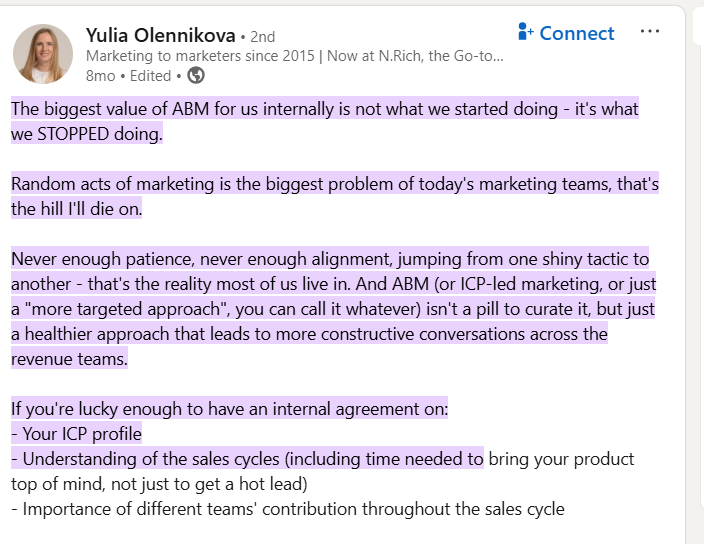
She, in fact, says that after 2024, even the very loved-stable-mainstream marketing tactics like lead generation through SEO seem to underperform when compared to ABM.
And I’d agree with the reasons she cites: How do you know all your web visitors are your ICPs? What makes you think high-value accounts are lurking on Google to read a 2500-word blog, after AI is here?
In short, traditional marketing treats every form-filler or report-downloader as a lead worth pursuing, which is severely flawed.
Just look at me – I have been a B2B SaaS freelance writer for a long while and have been writing articles in different B2B fields and have downloaded 100s of such reports for research, but as a freelance writer, I was never an apt lead for any of those businesses.
Benefit 6: Closer Marketing and Sales Alignment
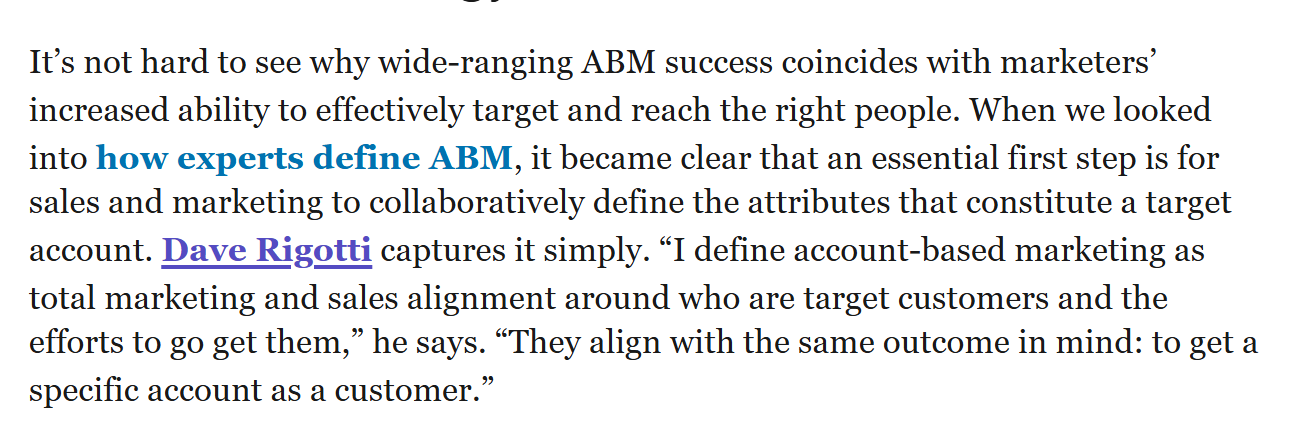
Perhaps the most praised benefit of ABM is how it aligns marketing and sales into one unified revenue team.
Unlike siloed demand gen, where marketing throws MQLs over the fence for sales to lure them, ABM requires constant collaboration between sales and marketing, from jointly defining the Target Account List (TAL) to coordinating outreach and account plans.
No wonder, a report by DemandGen found that 67% of companies say ABM has led to better sales–marketing alignment.
Sales and marketing alignment is both the prerequisite of an ABM and the outcome of the strategy, too!
Benefit 7: Personalized and Relevant Outreach at Scale
In an era where buyers tune out generic blasts, ABM delivers the personalization modern B2B buyers expect.
Plus, it does so in a scalable way.
Traditional demand gen might personalize an email greeting at best; ABM goes deeper, designing content, ads, and messaging to each target account’s pains and needs.
This hyper-relevance yields major engagement boosts.
One more thing: Personalization is not easy-peasy. It is resource-intensive, and you can’t put similar personalization efforts for your whole TAL. You must prioritize, and ABM keeps that in mind.
Most ABM playbooks start with segmentation based on tiers and corresponding efforts like these:
| Tier | Description | Approach | Typical ACV Contribution |
|---|---|---|---|
| Tier 1 | Your highest-value accounts – typically large enterprises or strategic logos with ACV potential at the top of your range. These accounts get the white-glove, one-to-one ABM treatment, including deep research, highly personalized content, and dedicated pursuit plans. | 1:1 ABM (highly personalized campaigns and content tailored individually per account) | >10–15% of segment revenue each |
| Tier 2 | Medium-value accounts that are great fits but not enterprise-level. They typically receive personalized campaigns tailored by industry or use-case rather than fully account-specific. Often termed “ABM Lite” or “Industry-Based Marketing,” these campaigns focus on common challenges within a specific segment or role. | 1:Few or 1:Cluster ABM (industry-specific or role-based campaigns) | Moderate ACV (~4–10% of segment revenue each) |
| Tier 3 | Lower-value or emerging accounts within your ICP that don’t justify heavy ABM investment. These accounts typically receive scaled marketing tactics (demand generation, inbound funnels) with minimal personalization. Individual outreach occurs mainly if strong intent signals appear. | 1:Many ABM / Scaled Marketing (automation and standard nurturing) | Low ACV (usually below the threshold for heavy ABM investment) |
Now, such an ACV-based segmentation ensures you don’t end up making a 1:1 dedicated $100 landing page for an account with a mere $500 ACV!
Benefit 8: Increased Upsell, Cross-Sell and Lifetime Value
Not only does ABM help land big new customers, but it also gets you growth within your existing accounts.
This is often an overlooked benefit of ABM.
ABM principles can be applied to customer expansion campaigns to drive upsells, cross-sells, and renewals.
Because ABM aligns your team around the full account, you naturally identify opportunities to expand the relationship.
In fact, 80% of marketers say ABM improves customer lifetime value (CLV) and upsell potential.
Using ZenABM to Realise the Benefits of an ABM Strategy
We discussed many proven benefits of ABM.
Now, let me show you how ZenABM can help you achieve them:
ABM Campaign Analytics Dashboards
ZenABM matches the companies engaging with your ad campaigns to the ones in your CRM deals to calculate the impact of ads on pipeline and revenue.
Then it lays that all out in plug-and-play dashboards showing metrics like ROAS, pipeline per $ spent, etc.

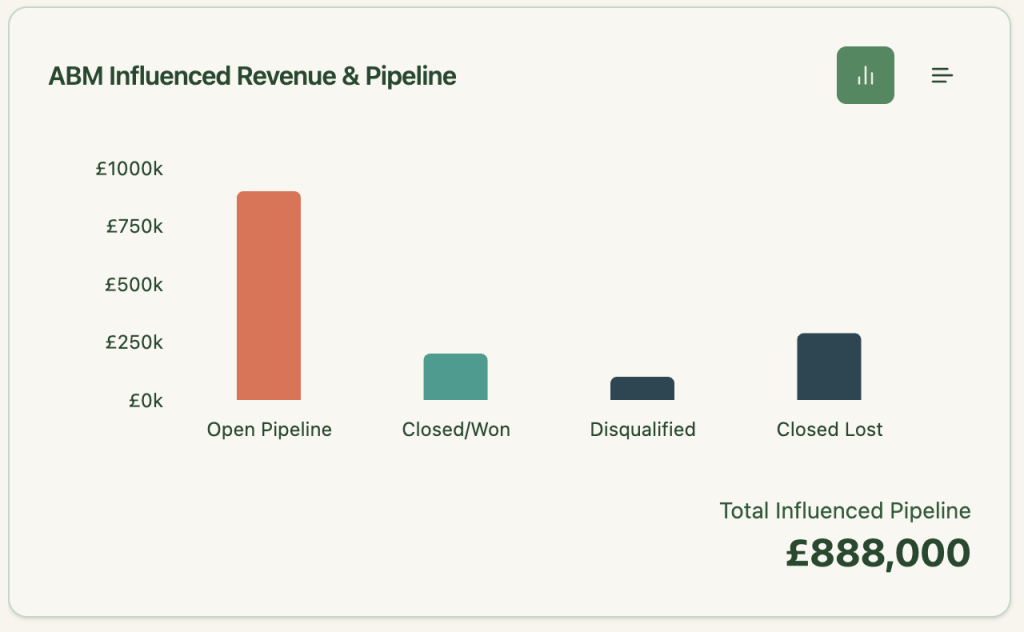
This helps identify which campaigns deliver real returns and reallocate the budget accordingly.
Company Metrics for Every Campaign and Group
ZenABM pulls verified data from the LinkedIn Ads API, giving impressions, clicks, CTR, spend and engagement for each campaign and group at the company level.

Intent-Based Engagement
You can label each campaign with its intent, such as a feature or a pain point. ZenABM then groups companies by the themes to which they respond.
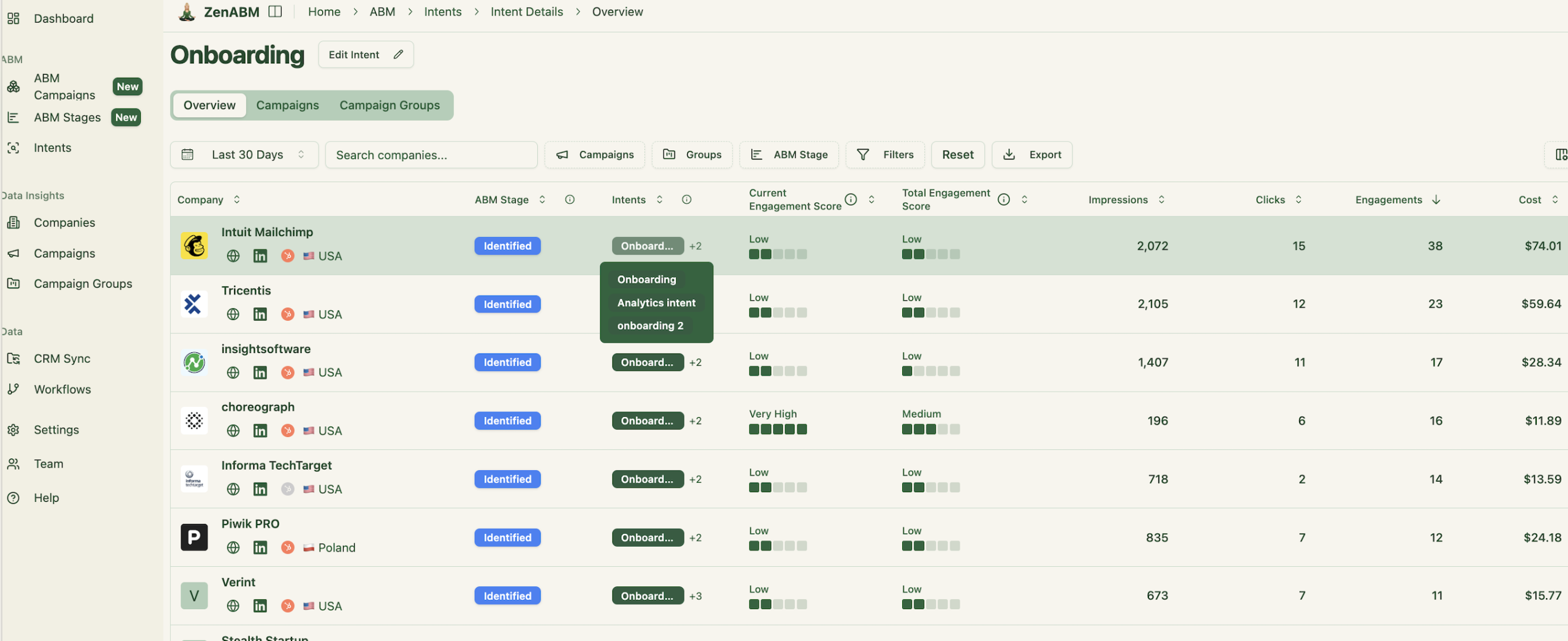
This helps you know which feature/quality of your business is the most relevant to your audience so you can double down on it. Plus, you also get to know each company’s buying intent.
Customisable ABM Stages
The platform places accounts into stages like Awareness and Interest using ad and CRM signals. Thresholds are editable.

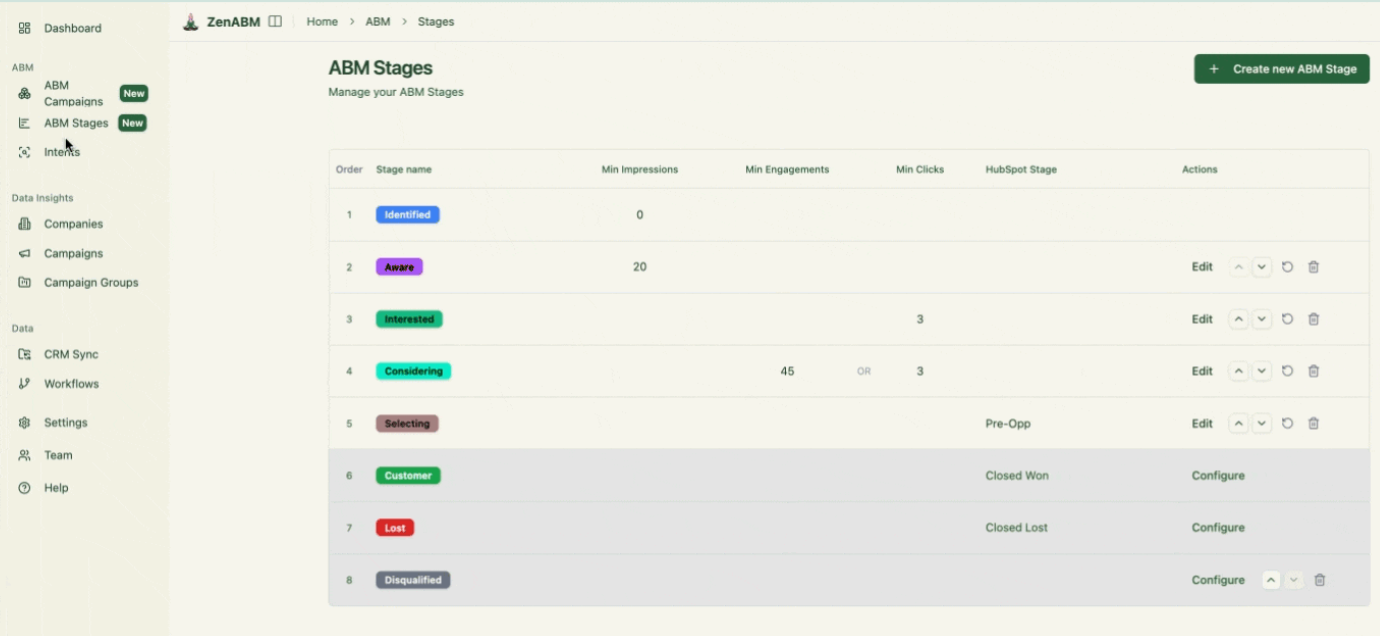
Live and Historical Scoring
Two scores calculated by ZenABM help your sales prioritise accounts:
- Live Engagement Score – recent activity signal
- Lifetime Engagement Score – cumulative interest indicator

Automatic CRM Sync
ZenABM writes impressions, clicks, scores, stages and intent back to Salesforce or HubSpot and assigns BDRs once an account meets your criteria.
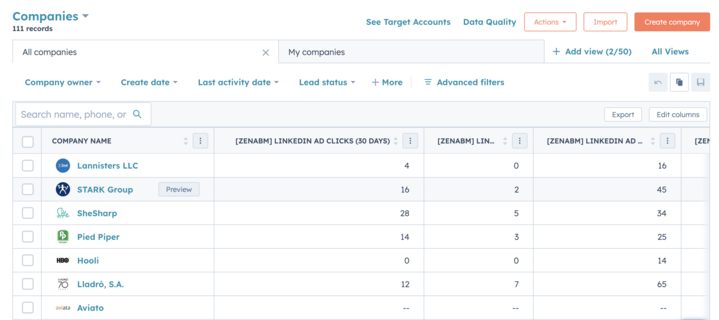
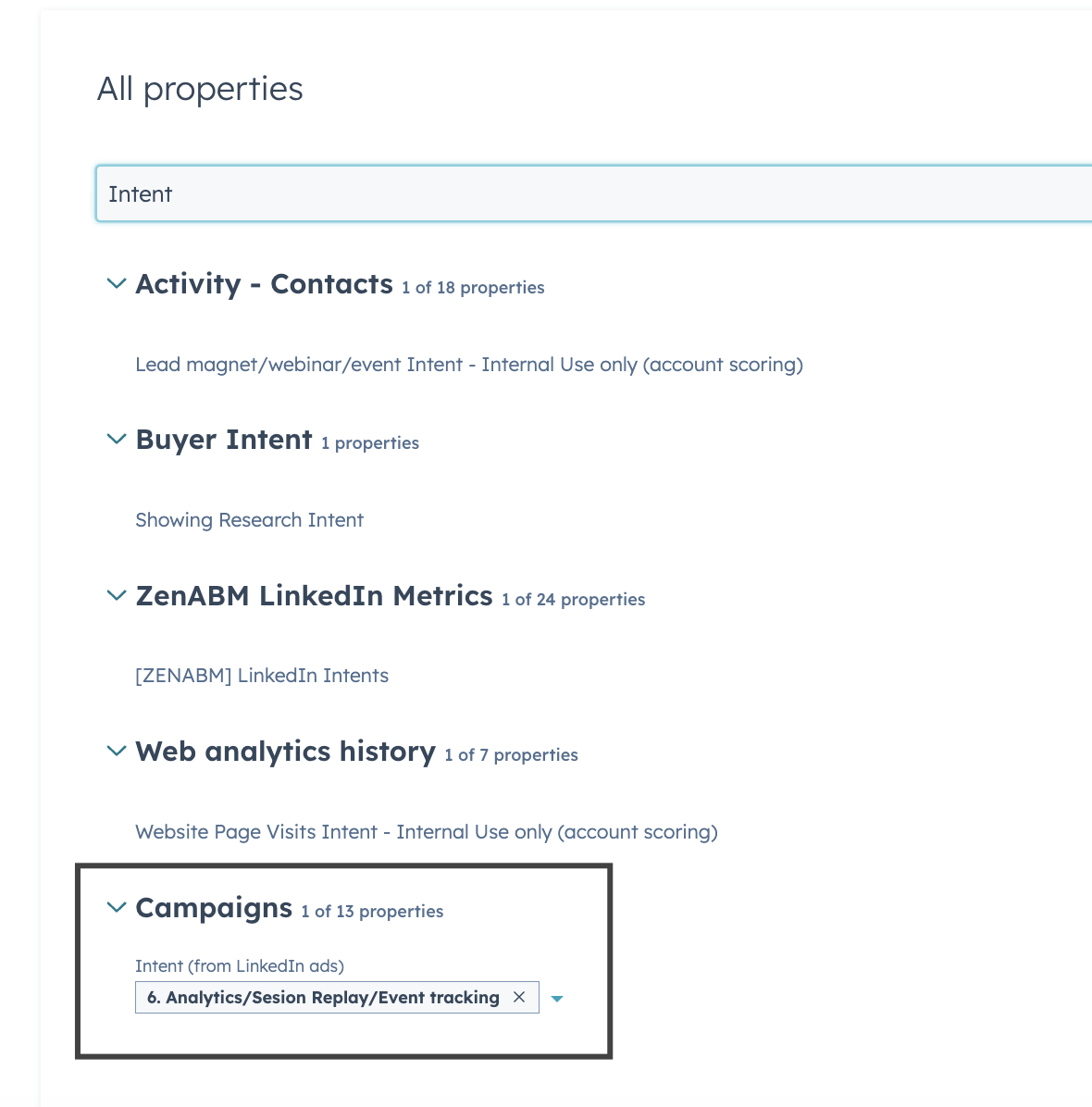

This ensures your BDRs act immediately when accounts become ‘hot’ and also incorporate the accounts’ buying into their outreach messaging. That’s critical for personalization.
Over to You
ABM isn’t hype. It’s a revenue engine.
Done right, it drives clear ROI, deeper engagement, and faster closes. While traditional lead gen chases volume, ABM targets high-fit accounts for real impact.
And ZenABM, with its company-level engagement tracking, stage tracking, and two-way CRM integration, can help you reap the benefits of an ABM strategy to the fullest.

